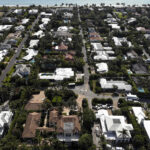Amandine Mamena stands among the ruins of her house. Nothing but the foundations remain.
Mamena, 36, lost everything when Cyclone Ivan slammed into the east coast of Madagascar. The cyclone hit Feb. 17 carrying winds of up to 140 mph and torrential rains, and left 83 people dead, 177 missing, and 187,000 people homeless, according to the latest government accounting.
“I don’t have the money to rebuild my house,” Mamena said. “I don’t know how we’ll find the money because all of it was in our crops, but they have been destroyed.”
Officials were still assessing affected regions on this vast island. The wooded hills of Madagascar’s east coast echoed with the sound of hammering as reconstruction got under way, but everyone appeared to be worried about food.
Latest figures suggest more than 100,000 acres of rice fields have been lost along with 300,000 acres of other cultivated land.
Didier Young of the aid organization Care International said a many people who lost their homes also lost what food they had stored away.
“A lot of people have nothing to eat and on top of that they have lost their crops. The next harvest should have happened in May but for most people the harvest will be virtually nothing,” he said.
The village of Ambodihazinina, where Mamena lives, lies just north of Fenerive Este, the capital of the Analagirofo region, the worst affected area in the country. Here alone, the government estimates that 80,000 people have lost their homes.
The countryside around Mamena’s village is beautiful. Wooded hills and forest run down to the Indian Ocean, and rice fields dot the landscape. But the devastation is everywhere, with vegetation, dwellings, schools and other infrastructure flattened. The road leading in is in poor condition, and some parts of the region remain inaccessible.
“Truly, this is a complete disaster,” said Gilbert Tarehy, regional administrator.
“The most important thing we need here is food. And as well as that we have a problem of bad water,” Tarehy said. “That’s why I appeal to the international community for help.”
Tarehy’s face darkened as Bruno Maes, the head of UNICEF in Madagascar, showed him a satellite photograph suggesting that more rain is forecast for the coming weeks.
Alexis Rakotonirina, a 56-year-old teacher working in Fenerive Este, said he feared starvation lay ahead for many in the region.
“There may also be mental health problems, because some of these people have no hope,” said Rakotonirina, who hid this his family hid under a table for the duration of the cyclone. His house was damaged.
North of Fenerive Este, villages like Ambodihazinina are emptied of men during the day. They are all in what remains of the forest — hunting for food among the devastated vegetation and flattened giant bamboo trees.
As night falls Justin Tombo, 58, sat next to the ruins of his house while the evening meal was prepared for his family of six. He smiled readily and seemed pleased to have visitors. However, Tombo says the situation is very serious.
“The week before the cyclone my rice fields were ripening. Now everything has gone. I don’t know what we will eat,” he said. “I will try to rebuild my house but as for my crops there is no hope. We will replant and try to survive. I will have to find a way to feed my family.”
Was this article valuable?
Here are more articles you may enjoy.

 Florida’s Home Insurance Industry May Be Worse Than Anyone Realizes
Florida’s Home Insurance Industry May Be Worse Than Anyone Realizes  Report: Claims Handlers Embracing Technology
Report: Claims Handlers Embracing Technology  California Chiropractor Sentenced to 54 Years for $150M Workers’ Comp Scheme
California Chiropractor Sentenced to 54 Years for $150M Workers’ Comp Scheme  Jury Awards $80M to 3 Former Zurich NA Employees for Wrongful Termination
Jury Awards $80M to 3 Former Zurich NA Employees for Wrongful Termination 